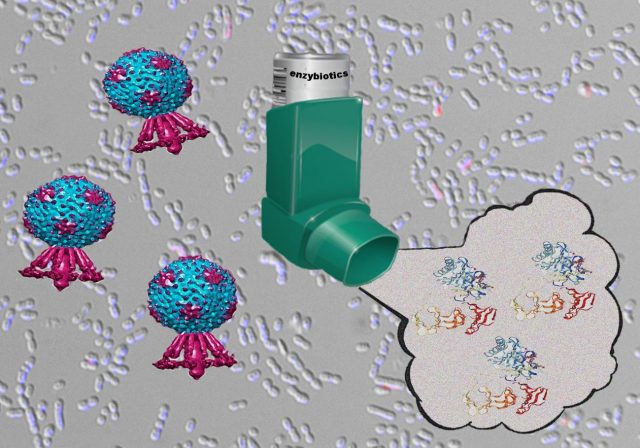Enzybiotics, from phages to the inhaler.
Authors: Fernando González-Camacho, Bruno Corsini and Jose Yuste work at Centro Nacional de Microbiología, Instituto de Salud Carlos III (ISCIII) and Centro de Investigación Biomédica en Red de Enfermedades Respiratorias (CIBERES), Madrid, Spain.

In the age of bacteria resistant to multiple antibiotics, the so-called superbacteria, it is critical to our future the development of novel therapeutic strategies. Lytic enzymes encoded by bacteriophages – viruses that specifically kill bacteria, also called lysins or enzybiotics, are effective agents for preventing and controlling diseases caused by Gram+ bacteria, including Streptococcus pneumoniae.
S. pneumoniae is one of the main causative agents of pneumonia, acute otitis media, bacterial meningitis and sepsis, becoming a public health problem worldwide. There are two main risk groups in the population, children and elderly people being patients with chronic obstructive pulmonary disease (COPD) highly susceptible to the infection. More than 30% of children are asymptomatic carriers of multiple pneumococcal serotypes located in the nasopharynx. Colonization of the upper respiratory tract can lead to the development of invasive pneumococcal disease (IPD), which is the most severe clinical manifestation.
In adults with COPD, pneumococcal infection is associated with exacerbation and inflammation in the lungs.
We have recently evaluated the antibacterial activity of three different lysins, Cpl-1, Cpl-7s and Cpl-711 that act against the pneumococcal colonies present in the respiratory tract 1. We have studied multiresistant pneumococcal strains (MDR) attached to the human nasopharynx and lung epithelial cells. In addition, we have studied their ability to eliminate pneumococci from the nasopharynx using a mouse infection model.
Human epithelial cells were infected with three multiresistant clinical isolates of S. pneumoniae and then treated with the corresponding lysin or placebo. Parallel experiments were done in a mouse model to check the antimicrobial activity of the three lysins.
The results show that treatment with Cpl-1 or with Cpl-711 increases the death of S. pneumoniae that is adhered to the human epithelial cells, being Cpl-711 more efficient than Cpl-1. On the other hand, intranasal treatment of mice with Cpl-711 showed a significant reduction of nasopharyngeal colonization, showing that in 20-40% of mice a complete clearance was found.
The lysins Cpl-1 and Cpl-711 have specific pneumococcal activity against bacteria that form and live in biofilm and against planktonic bacteria, and therefore, are good candidates as antimicrobial drugs against colonization.
In this work, we demonstrate the efficiency of lysins against colonization by S. pneumoniae. This is important since, generally, the nasopharyngeal carrier state by S. pneumoniae is a prerequisite for invasive disease. From a clinical perspective, the situation is even worse, with multiresistant isolates that are a frequent cause of persistent infections in COPD patients and resistance to antibiotics compromises treatment.
Our results suggest that Cpl-1 and Cpl-711 can be used as a new therapeutic strategy to fight against persistent colonization of the respiratory tract by S. pneumoniae.
Cpl-711 was the most efficient lysin tested, reducing the pneumococci adhered to the epithelial cells of the respiratory tract being efficient both in reducing the colonization of cellular tissues and the mucosa which may be very important with a prophylactic perspective, as a decolonizing drug.
Patients with COPD who have a pneumococcal infection have an additional difficulty, the bacteria remain persistently in their lower respiratory tract. Therefore, in the future it could be interesting to administer Cpl-1 or Cpl-711 intranasally in a similar way to other treatments with conventional inhalers with the aim of decreasing the pneumococcal adhesion in the lungs This hypothetical therapeutic approach could be useful for the resolution of the infection in patients who have recurrent episodes of pneumonia associated with COPD or other chronic respiratory conditions in which S. pneumoniae is one of the main etiological agents.
The use of lysins may be a promising therapy to prevent transmission among children who are the main carrier of S. pneumoniae with many serotypes simultaneously colonizing the nasopharynx.
References
- Corsini B, Díez-Martínez R, Aguinagalde L, González-Camacho F, García-Fernández E, Letrado P, García P, Yuste J. 2018. Chemotherapy with phage lysins reduces pneumococcal colonization of the respiratory tract. Antimicrob Agents Chemother 62:e02212-17. https://doi.org/10.1128/AAC.02212-17 ↩
2 comments
[…] Superbakterioen, antibiotikoei erresistenteak diren bakterioen, garaian sartzen ari gara. Haien aurkako arma berrien garapena beharrezkoa da, beraz. Enzobiotikoak, adibidez. Fernando González-Camacho, Bruno Corsini eta José Yuste horretan dabiltza: Enzybiotics, from phages to the inhaler. […]
[…] Estamos entrando en la era de las superbacterias, resistentes a los antibióticos actuales. Se hace necesario pues el desarrollo de nuevas armas contra ellas. Como los enzibióticos. Fernando González-Camacho, Bruno Corsini y José Yuste están trabajando en ello y […]